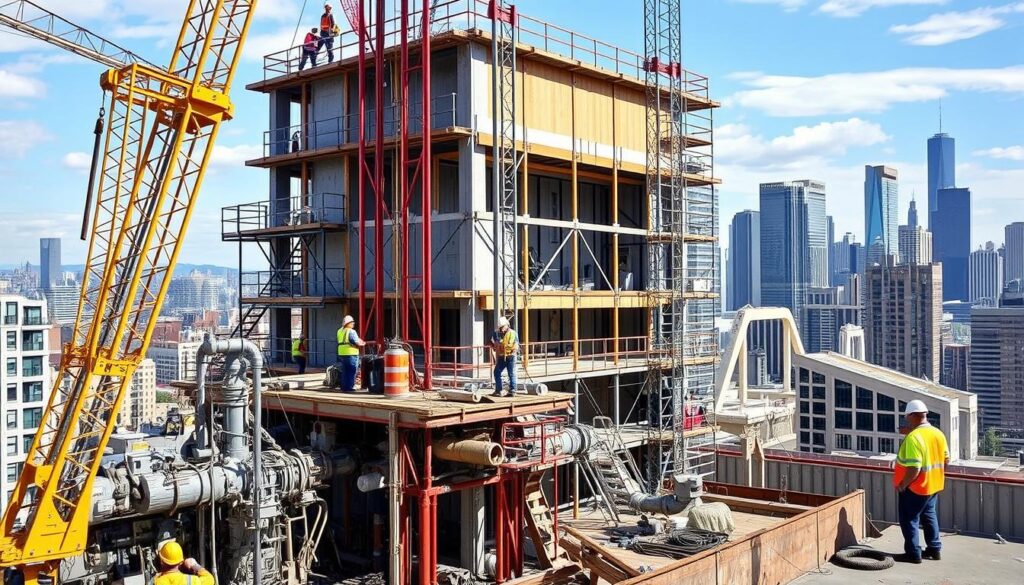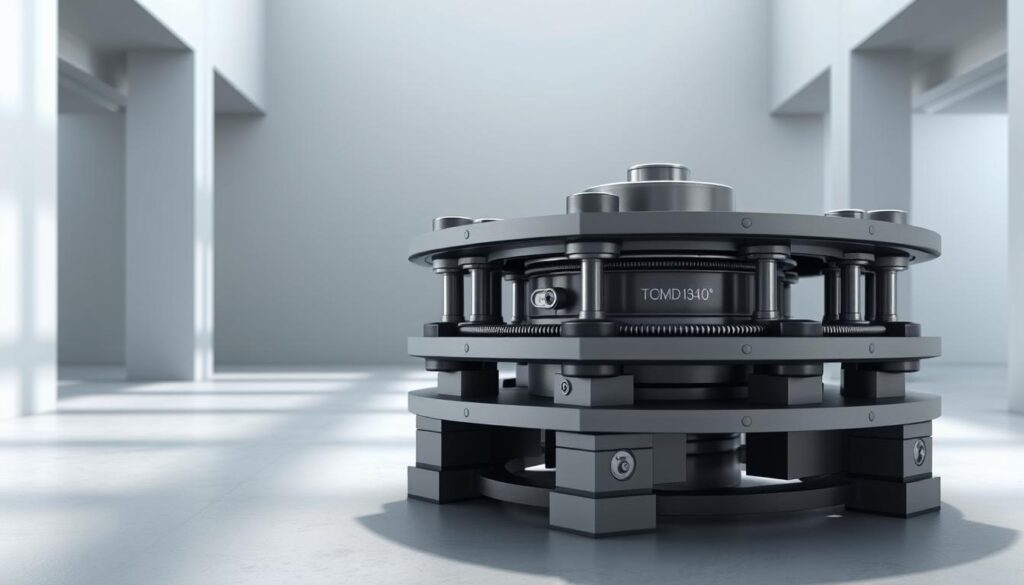Every year, earthquakes cause widespread destruction and loss of life, with significant economic impacts on communities worldwide. In regions prone to seismic activity, such as the West Coast of the United States, earthquake-resistant design is crucial for safeguarding buildings and infrastructure. One technique that has gained prominence in mitigating earthquake damage is seismic isolation, particularly through the use of base isolators. Base isolation involves decoupling a building from the ground, allowing it to move independently during seismic events, thus reducing the transfer of seismic forces to the structure.
This technique has been successfully implemented in various countries, including New Zealand, India, Japan, Italy, and the USA, showcasing its effectiveness in enhancing earthquake resilience.
Key Takeaways
- Seismic isolation is a technique used to minimize earthquake damage to buildings.
- Base isolators play a crucial role in decoupling buildings from the ground.
- Countries like New Zealand, India, and Japan have successfully implemented base isolation.
- Seismic isolation enhances the resilience of structures during earthquakes.
- Base isolation is a key component of earthquake-resistant design.
What Are Base Isolators?
Seismic base isolators are innovative devices designed to decouple buildings from the ground, reducing the impact of earthquakes. This technology has become a cornerstone in earthquake engineering, providing a critical layer of protection for structures.
Definition and Purpose
Base isolators are essentially devices placed between a building and its foundation to absorb seismic energy, thereby reducing the transmission of seismic forces to the structure. The primary purpose of these isolators is to enhance the safety and integrity of buildings during earthquakes. For more detailed information on how base isolators work in conjunction with other seismic technologies, visit this resource on base isolation and seismic dampers.
The use of base isolators allows buildings to move independently of the ground during seismic activity, significantly reducing the risk of damage. This is achieved through the isolators’ ability to absorb and dissipate the energy generated by the earthquake.
Types of Base Isolators
There are several types of base isolators used in earthquake engineering, each with its unique characteristics and applications. The main types include:
- Elastomeric isolators, which are made from layers of rubber and steel.
- Sliding isolators, which allow for movement between the building and the foundation.
- Lead-rubber bearings, a type of elastomeric isolator that incorporates lead to enhance energy dissipation.
| Type of Base Isolator | Description | Key Features |
|---|---|---|
| Elastomeric Isolators | Made from layers of rubber and steel, these isolators provide flexibility and durability. | High flexibility, durable |
| Sliding Isolators | Allow for sliding movement between the building and the foundation, reducing seismic force transmission. | Low friction, adaptable |
| Lead-Rubber Bearings | Incorporate lead to enhance energy dissipation, providing additional seismic protection. | High energy dissipation, robust |
In conclusion, base isolators are a vital component in the design of earthquake-resistant buildings. By understanding the different types and their purposes, engineers and architects can make informed decisions to enhance building safety and resilience.
The Importance of Earthquake-Resistant Design

The significance of earthquake-resistant design cannot be overstated, especially in regions vulnerable to seismic activity. Earthquake-resistant design is crucial for minimizing damage and ensuring the safety of buildings and their occupants during earthquakes.
Key Concepts in Seismic Safety
Seismic safety involves several key concepts, including the use of base isolation technology and seismic retrofitting. Base isolation technology is designed to decouple buildings from the ground, reducing the transmission of seismic forces. Seismic retrofitting involves upgrading existing structures to make them more resistant to earthquakes.
Understanding these concepts is vital for architects, engineers, and builders working on projects in seismic-prone areas. For more detailed information on base isolation, refer to this resource on base isolation for earthquake.
| Seismic Safety Measure | Description | Benefits |
|---|---|---|
| Base Isolation Technology | Decouples buildings from the ground to reduce seismic force transmission | Reduces structural damage, enhances building safety |
| Seismic Retrofitting | Upgrades existing structures to improve earthquake resistance | Enhances structural integrity, reduces risk of collapse |
Historical Context of Earthquake Engineering
The field of earthquake engineering has evolved significantly over the years, driven by advances in technology and lessons learned from past earthquakes. Historically, earthquake-resistant design was not a priority, leading to significant damage and loss of life in seismic events.
The development of modern seismic design principles and techniques, including base isolation technology, has marked a significant shift towards more resilient construction practices. Understanding the historical context of earthquake engineering provides valuable insights into the evolution of seismic retrofitting techniques.
How Base Isolators Function
By allowing a building to move independently of the ground, base isolators significantly enhance earthquake resistance. This is achieved through a sophisticated system that decouples the structure from the ground motion, thereby reducing the transmission of seismic forces to the building.
The Physics Behind Base Isolation
The physics behind base isolation involves the use of specialized devices that absorb seismic energy. These devices, typically made of rubber or other flexible materials, are placed between the foundation and the superstructure of the building. By doing so, they enable the building to move laterally during an earthquake, thus reducing the stress and strain on the structure.
Base isolation systems work on the principle of seismic base isolation, which is designed to reduce the transmission of seismic forces to the building. This is accomplished by increasing the fundamental period of the structure, making it less responsive to ground motion.
Energy Dissipation Mechanisms
Energy dissipation mechanisms are critical components of base isolation systems. These mechanisms are designed to absorb and dissipate the energy generated by seismic activity. Common energy dissipation devices include viscous dampers, which absorb energy through the movement of a viscous fluid, and hysteretic dampers, which dissipate energy through the deformation of metallic materials.
The combination of base isolation and energy dissipation mechanisms provides a robust earthquake-resistant design solution. By understanding how these systems work together, engineers can design buildings that are better equipped to withstand seismic events, ultimately enhancing the safety of occupants and reducing the risk of structural damage.
Advantages of Using Base Isolators

By decoupling buildings from the ground, base isolators significantly reduce the impact of seismic forces. This technology has proven to be a game-changer in earthquake engineering, offering numerous benefits that enhance the overall resilience of structures.
Enhanced Building Safety
The primary advantage of base isolators is their ability to enhance building safety during seismic events. By isolating the structure from the ground, these devices minimize the transfer of seismic energy, thereby reducing the risk of damage and collapse. This is particularly crucial for buildings that house critical infrastructure or a large number of occupants.
Studies have shown that buildings equipped with base isolators can withstand earthquakes with significantly less damage compared to those without. For instance, a study on the effectiveness of base isolation technology highlighted its potential to reduce seismic forces by up to 70%.
Reduced Structural Damage
In addition to enhancing safety, base isolators also play a critical role in reducing structural damage. By minimizing the seismic forces that act on a building, these devices help preserve the integrity of the structure, reducing the need for costly repairs and downtime following an earthquake.
| Benefits | Description | Impact |
|---|---|---|
| Enhanced Safety | Minimizes the risk of damage and collapse | High |
| Reduced Damage | Preserves structural integrity | Medium |
| Cost Savings | Reduces repair and downtime costs | High |
The use of base isolators represents a significant advancement in seismic isolation technology, offering a proactive approach to mitigating the effects of earthquakes on buildings. As the field of earthquake engineering continues to evolve, the integration of base isolators is likely to become increasingly prevalent.
Applications of Base Isolators
From residential homes to critical infrastructure, base isolators play a vital role in enhancing seismic safety. The versatility of base isolation technology allows it to be applied across various building types, providing a robust defense against earthquakes.
Residential Buildings
In residential construction, seismic base isolators are used to protect homes from earthquake damage. By decoupling the building from the ground, these systems reduce the transmission of seismic forces, thereby safeguarding the structure and its occupants.
Commercial Buildings
Commercial buildings, which often house large numbers of people and valuable assets, benefit significantly from the installation of base isolators. These systems not only enhance the safety of occupants but also minimize potential economic losses by reducing structural damage.
Critical Infrastructure
Critical infrastructure, such as hospitals, emergency services, and data centers, require uninterrupted functionality during and after seismic events. Base isolation technology is particularly crucial for these facilities, as it ensures their continued operation, even in the face of significant earthquakes.
| Building Type | Benefits of Base Isolators | Key Considerations |
|---|---|---|
| Residential | Enhanced safety, reduced damage | Cost, design complexity |
| Commercial | Minimized economic loss, occupant safety | Integration with building design |
| Critical Infrastructure | Uninterrupted functionality, seismic resilience | High initial investment, specialized design |
Challenges in Implementing Base Isolators

Despite the benefits of base isolators, their implementation is fraught with challenges, including cost and design limitations. Understanding these challenges is crucial for applying seismic design principles effectively. The complexity of integrating base isolators into a building’s design requires careful consideration of various factors.
Cost Considerations
The cost of implementing base isolators can be significantly higher than traditional construction methods. This increased cost is due to the specialized materials and expertise required for seismic retrofitting. However, the long-term benefits, including reduced damage and potential savings on repair costs, can offset the initial investment.
Design Limitations
Designing a building with base isolators poses several challenges, including ensuring that the isolators are compatible with the building’s structural system. Architects and engineers must carefully consider the seismic design principles to ensure that the base isolators function as intended, providing the desired level of seismic protection.
The design process also involves modeling and testing to validate the performance of the base isolators under various seismic scenarios. This process can be complex and requires advanced technical expertise.
The Future of Base Isolation Technology
The future of seismic isolation is bright, with innovations on the horizon that promise to enhance building safety. As research continues to advance, we can expect to see more sophisticated and effective base isolation systems.
One of the key areas of development is in the materials used for base isolators. New materials and technologies are being explored to improve the performance and durability of these systems. For instance, advancements in rubber compounds and other elastomeric materials are enhancing the energy dissipation capabilities of base isolators.
Innovations on the Horizon
Several innovations are being researched and implemented in the field of base isolation. Some of these include:
- Advanced Materials: New materials are being developed to improve the durability and performance of base isolators.
- Smart Technologies: Integration with smart technology is enabling real-time monitoring and adjustment of base isolation systems.
- Modular Designs: Modular base isolation systems are being designed for easier installation and maintenance.
These innovations are expected to significantly improve the effectiveness of base isolators in earthquake-resistant design.
Integration with Smart Technology
The integration of base isolation technology with smart technology is a significant development. Smart base isolators can be monitored and adjusted in real-time, allowing for more effective seismic response. This integration enables:
| Feature | Benefit |
|---|---|
| Real-time Monitoring | Immediate assessment of seismic activity and system response. |
| Adaptive Response | Base isolators can adjust to different seismic conditions for optimal performance. |
| Predictive Maintenance | Potential issues can be identified and addressed before they become critical. |
As base isolation technology continues to evolve, its integration with smart technology will play a crucial role in enhancing earthquake-resistant design. By leveraging these advancements, we can create safer, more resilient buildings and infrastructure.
Case Studies of Successful Base Isolator Installations

Examining successful base isolator installations provides valuable insights into their benefits and challenges. Base isolation technology has been increasingly adopted in earthquake-prone areas to enhance the seismic resilience of buildings.
Notable Buildings Using Base Isolators
Several notable buildings around the world have successfully utilized base isolators to enhance earthquake resistance. For instance, the Tokyo Skytree in Japan, one of the tallest towers globally, was equipped with base isolation technology to withstand seismic activity. Similarly, the San Francisco City Hall in the United States underwent seismic retrofitting that included the installation of base isolators to protect it from earthquakes.
These examples demonstrate the effectiveness of base isolation in safeguarding critical infrastructure and historical buildings. The use of base isolators allows these structures to remain operational even after significant seismic events, thereby reducing the economic and social impact of earthquakes.
“The implementation of base isolators has revolutionized earthquake engineering by providing a reliable means to protect structures from seismic damage.”
Lessons Learned from Case Studies
Analyzing case studies of successful base isolator installations reveals several key lessons. Firstly, the importance of proper design and installation cannot be overstated. Incorrect implementation can lead to reduced effectiveness or even failure of the base isolation system.
- Thorough site analysis is crucial before installing base isolators.
- The design must consider the specific seismic hazard of the area.
- Regular maintenance is necessary to ensure the longevity and effectiveness of base isolators.
By understanding these lessons, engineers and builders can better implement base isolation technology, enhancing the earthquake resilience of structures. As earthquake engineering continues to evolve, the role of base isolators is likely to become even more significant.
Maintenance of Base Isolators
To maximize the lifespan and performance of base isolators, a rigorous maintenance schedule is necessary. Regular maintenance ensures that these critical components continue to function as intended, providing the necessary seismic protection for structures.
Inspection and Monitoring
Regular inspection and monitoring are crucial for identifying any potential issues with base isolators before they become significant problems. This involves checking for signs of wear, damage, or degradation that could affect their performance. Advanced monitoring systems can provide real-time data on the condition of base isolators, enabling prompt maintenance or repairs as needed.
For instance, a study published in the Open Civil Engineering Journal highlights the importance of regular inspections in maintaining the integrity of seismic base isolators. The study emphasizes that consistent monitoring can significantly enhance the overall safety and resilience of structures during seismic events.
Long-Term Care Practices
Long-term care practices for base isolators include ensuring that they are properly protected from environmental factors that could cause deterioration. This may involve applying protective coatings or sealants to prevent corrosion or damage from exposure to the elements. Additionally, it’s essential to ensure that base isolators are not compromised during any construction or renovation activities around or on the structure.
Effective long-term care also involves maintaining detailed records of all maintenance activities, inspections, and any repairs or replacements made to the base isolators. This documentation is invaluable for planning future maintenance and ensuring compliance with relevant seismic retrofitting standards.
By adopting a proactive approach to the maintenance of base isolators, building owners and managers can significantly enhance the seismic resilience of their structures, protecting both the building and its occupants from the potentially devastating effects of earthquakes.
Comparing Base Isolators to Other Seismic Techniques

Base isolators are a crucial component in earthquake-resistant design, but they are not the only method used. Understanding the differences between base isolators and other seismic techniques is essential for applying seismic design principles effectively.
Traditional Building Methods
Traditional building methods often rely on the inherent strength and ductility of the structure to resist seismic forces. This approach can be effective for low-to-moderate seismic activity but may not be sufficient for high-intensity earthquakes. In contrast, base isolators decouple the building from the ground, significantly reducing the seismic forces transmitted to the structure.
A comparison of traditional methods and base isolation techniques is provided in the following table:
| Technique | Description | Effectiveness in High Seismic Activity |
|---|---|---|
| Traditional Building Methods | Rely on structural strength and ductility | Limited |
| Base Isolation | Decouples building from ground motion | High |
Alternative Isolation Technologies
Besides base isolators, other seismic isolation technologies include seismic isolation bearings and sliding isolation systems. These alternatives offer varying degrees of effectiveness and applicability depending on the building design and seismic hazard.
For instance, seismic isolation bearings can be used in retrofitting existing buildings, providing a flexible solution for enhancing seismic resilience. The choice between different isolation technologies depends on factors such as building type, seismic hazard, and cost considerations.
By understanding the advantages and limitations of each seismic technique, engineers can make informed decisions to enhance building safety and resilience against earthquakes.
Regulatory Standards for Base Isolators
Understanding the regulatory framework surrounding base isolators is essential for their successful integration into building designs. Regulatory standards play a crucial role in ensuring that base isolators are designed, tested, and installed correctly to provide the desired level of earthquake resistance.
Building Codes and Guidelines
Building codes and guidelines are critical in governing the use of base isolators. These codes often specify requirements for the design, materials, and testing of base isolators. For instance, the University of Canterbury’s research on seismic isolation highlights the importance of adhering to these standards to ensure the effectiveness of base isolation systems.
The design of base isolators must comply with local building codes, which can vary significantly from one region to another. This variability underscores the need for engineers and architects to be well-versed in the specific regulations applicable to their project locations.
Compliance with Local Regulations
Compliance with local regulations is not only mandatory but also crucial for the safety and efficacy of base isolation systems. Local regulations often reflect the specific seismic hazards and construction practices of a region, making compliance essential for ensuring that buildings are adequately protected against earthquakes.
To illustrate the regulatory standards for base isolators, consider the following table, which outlines key aspects of compliance:
| Regulatory Aspect | Description | Importance |
|---|---|---|
| Design Specifications | Detailed requirements for the design of base isolators, including materials and dimensions. | Ensures that base isolators can withstand seismic forces. |
| Testing Protocols | Standardized testing procedures to validate the performance of base isolators. | Verifies the effectiveness of base isolators under seismic conditions. |
| Installation Guidelines | Procedures for the correct installation of base isolators in buildings. | Critical for ensuring that base isolators function as intended during an earthquake. |
By adhering to these regulatory standards and guidelines, engineers and architects can ensure that base isolators are used effectively in earthquake-resistant design, enhancing the safety and resilience of buildings.
Expert Opinions on Base Isolators

Experts in structural engineering and seismology offer valuable insights into the benefits and challenges of using base isolators. Their opinions provide a deeper understanding of how base isolation technology can enhance earthquake-resistant design.
Interviews with Structural Engineers
Structural engineers play a crucial role in designing buildings that incorporate base isolators. According to a leading structural engineer, “Base isolators are a critical component in modern seismic design, allowing buildings to decouple from ground motions and reducing the risk of damage.” Recent innovations in base isolation technology have further improved their effectiveness.
The advantages of using base isolators include:
- Enhanced building safety during seismic events
- Reduced structural damage, leading to lower repair costs
- Increased flexibility in building design
Insights from Seismologists
Seismologists provide critical insights into the seismic activity that base isolators are designed to mitigate. “Understanding the seismic hazard is key to designing effective base isolation systems,” notes a prominent seismologist. “By analyzing seismic data, we can better predict how base isolators will perform during an earthquake.”
The key factors seismologists consider when evaluating base isolators include:
- The type of seismic activity in the region
- The frequency and amplitude of seismic waves
- The soil conditions and their impact on seismic wave propagation
By combining the expertise of structural engineers and seismologists, the design and implementation of base isolators can be significantly improved, leading to safer and more resilient structures.
Education and Awareness on Earthquake Safety
Educating the public about earthquake safety and base isolators can significantly reduce damage and loss of life. By promoting seismic retrofitting and seismic design principles, communities can become more resilient to earthquakes.
Effective education and awareness campaigns involve various stakeholders, including local governments, educational institutions, and community organizations. These efforts help in disseminating critical information about earthquake safety measures, such as the importance of base isolators in building design.
Community Outreach Programs
Community outreach programs play a vital role in earthquake safety education. These programs often include workshops, seminars, and public awareness campaigns that educate residents on how to prepare for earthquakes and the benefits of using base isolators in construction.
For instance, a community outreach program might involve:
- Conducting earthquake drills and safety training sessions
- Distributing informational materials on seismic retrofitting and base isolators
- Collaborating with local builders and architects to promote seismic design principles
Role of Educational Institutions
Educational institutions are crucial in promoting earthquake safety awareness. Schools and universities can integrate earthquake safety and seismic design principles into their curricula, ensuring that future generations are well-informed about earthquake risks and mitigation strategies.
Moreover, educational institutions can serve as hubs for community education, hosting workshops and seminars on earthquake safety and the importance of seismic retrofitting. By engaging students and the broader community, these institutions can foster a culture of earthquake resilience.
Resources for Further Learning
For those interested in delving deeper into the world of seismic isolation and base isolators, numerous resources are available. Understanding how base isolators work in earthquake-resistant design is crucial for advancing in this field.
Recommended Reading Materials
Several books and articles provide comprehensive insights into seismic isolation. Notable publications include research papers on the physics behind base isolation and its applications in various structures. These materials offer a detailed look into the mechanisms and benefits of seismic isolation.
Online Education and Training
Online courses and workshops are also available, focusing on the design, implementation, and maintenance of base isolators. These educational resources are invaluable for professionals and students alike, offering practical knowledge on seismic isolation techniques and their role in earthquake-resistant design.
